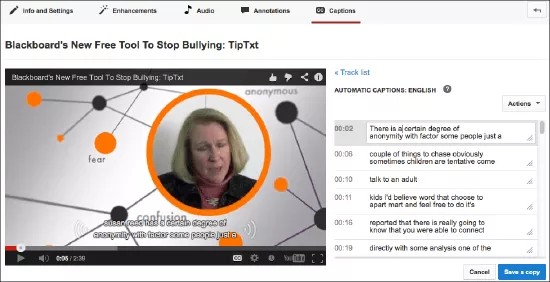Caption Video Content
About captioning
If you want to fully engage learners with video content, add captions. Captioning video creates accessible content for individuals who are deaf or hearing impaired. Captions are also important for anyone working in a noisy environment. Captions add another dimension to video content, making a richer learning experience for students who have specific neurological processing problems, non-native speakers, adults working toward basic literacy, and children learning to read.
Different types of captions
The following list includes the different types of captioning. Not all types of captioning fulfill all accessibility requirements.
- Closed Captions: Video that has closed captions is denoted with a familiar CC icon
. Blackboard Learn provides auto-captioning for the critical functions of video and audio instructor assessment feedback and announcements. Blackboard Learn also provides full support for captions in all media types that you can upload or view within your course content. Using closed captions is optional. Users can turn them on or off with their video player or other controls. Closed captions for video on television are read by a decoder that is part of the hardware of all television sets sold in the United States. Closed captions for video on the web are read by a media player if it supports closed captions. Not all versions of media players support closed captions. Closed captions are not part of the actual video stream and exist in a separate text stream.
Users who want to access closed captions need to understand how to turn them on from their televisions or media players. Include instructions for users in your course.
- Open Captions: Video that is accessed on the web can use open captions to provide on-screen text. Open captions are always displayed because they are part of the video stream. Open captions are not subject to different media player features. Users do not have to know how to turn the captions on. A disadvantage of open captions is that if the video is compressed, there can be a loss of quality and readability. They can also be distracting to some users.
- Audio Description: Adding a written description of sound effects such as "floor creaking" or "glass shattering" provides a richer experience for viewers. Audio descriptions are part of open or closed captions. They can fill in missing information a narrator fails to provide. For example, if a narrator says, "As you can see, the three main points support the conclusion," but doesn't say what those three main points are, audio description provides the missing information in the captions.
The easiest way to avoid requiring audio description in the example is to have a storyboard that the narrator follows that details visual information out loud.
- Real-time Captions: Taking place during a synchronous event such as streaming video or a Blackboard Collaborate session, real-time captioning, sometimes referred to as real-time text, is a transcription service similar to TDD/TTY for telephones. Transcription services are separate from Blackboard Learn. There is usually a cost for the service and the service needs to be arranged in advance of the event.
- Subtitles: Translating just dialog and not including sound effects or other description, subtitles assume that viewers can see and hear. Only spoken dialog is captioned and often translated into a different language.
Finding captioned content
The easiest and fastest way to add captioned content to your course is to locate videos that already have captions. A relatively small percentage of videos are captioned, but you can locate them by filtering your search. In YouTube, enter your search term and then add a comma followed by cc. For example, when searching for captioned videos on MOOCs, type "MOOC, cc" in the search box.
iTunes and Hulu have filters to help you locate videos that have captions. Just because a video has captions doesn't make the actual content any better or worse than uncaptioned videos. Before adding a captioned video to your course, play it all the way through to ensure the captions are accurate and the content is what you are expecting.
How to caption a video with YouTube
You can caption any videos that you own, meaning you uploaded them to your YouTube™ account. YouTube's automatic captioning service provides a solid start to captioning your videos.
Having a storyboard is important, even if you are making informal videos. Have an outline and what you are going to say typed out. This takes a little extra time up front, but it saves time in the long run. With a storyboard, you'll sound better in your video, and you'll make fewer retakes. You'll also be able to copy and paste your narration into YouTube instead of retyping it into the caption editor.
- Type an outline and basic storyboard.
- Create your video.
- Upload the video to YouTube.
- Wait two to six hours.
- Log back in to YouTube and select Video Manager.
- Select Edit and select Captions.
- Select Automatic Captions.
- Edit the existing captions. Sometimes the automatic approximations are hilarious so this is fun.
Although YouTube's automatic captioning is far from perfect, it will get you 80 percent of the way there. The clearer your speaking voice and diction, the better results you'll get. The best part of the automatic captioning tool is the time codes are synched to your content. All you need to do is edit the existing text in each frame.


